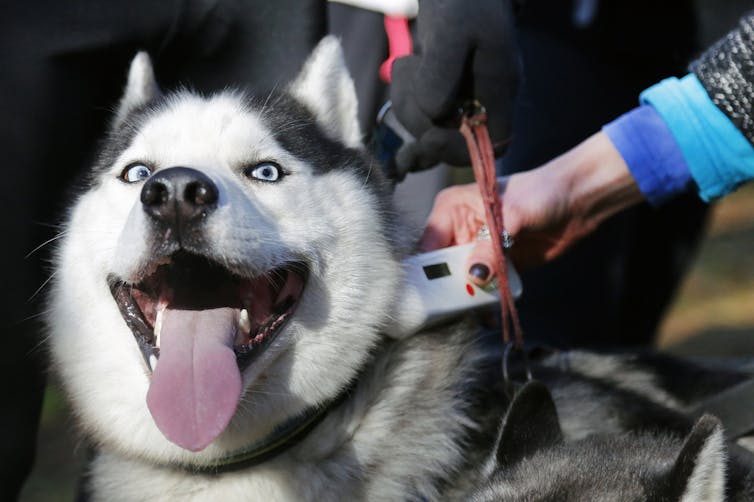When I was growing up, seeing a dog tied up outside a shop while the owner popped inside was commonplace. Although a rarer sight these days, it makes me cringe. Not because of the often expectant pooch waiting patiently by the door, but because of the very real possibility that the dog may not be there when the owner returns.
The number of dogs reported lost or stolen is on the rise and there has been a 33% rise in the number of reported dog thefts in the UK from 1,333 in 2014 to 1,797 in 2015. Nor is the problem confined to the UK – similar trends are also evident in the US, Australia and Canada.
There is also a growing market for these stolen dogs – often fuelled by unsuspecting new owners or backyard breeders – and while they continue to be of value to thieves, the trend in dog thefts will sadly continue. Despite a call for harsher sentencing for dog theft crimes, the theft of a dog in the Britain is currently still categorised as the theft of personal possessions (the equivalent offence of stealing a mobile phone).
In 2013, only 98 arrests were made relating to dog thefts and of these just 5% led to convictions. Nothing appears to have improved since then. Minimum sentences can be as little as community service or a fine.
Most at risk
The type of dogs stolen reflects those that are of highest value for resale and breeding. Pedigree dog breeds can been worth hundreds, sometimes thousands of pounds. Desirable breeds, such as French bulldogs and Chihuahuas, and those with unusual colours are particularly vulnerable.
Working gundogs, such as Labrador retrievers and springer and cocker spaniels are also highly-prized breeding dogs – but some are also stolen to become bait dogs for illegal dog fighting.

Thefts are often opportunistic, and dogs left unattended outside shops, or in cars and gardens are most likely to be taken. But there is also a worrying rise in the number of dogs being grabbed from unsuspecting owners while out for a walk or stolen during house and kennel break-ins.
In fact, it now appears that half of stolen dogs are taken from inside the home. More recently, dog walkers’ vans have become a targeted for the highly-prized breeds inside. The organised and nature of such thefts reveals it is becoming big business.
Steps can be taken to keep your dog safe and reduce the risk of theft. Make sure your house is secure, including good window and door locks. Avoid leaving dogs unattended in gardens. Gardens where dogs are visible pose a higher risk of theft, but even those that appear secure can be entered by determined thieves (and indeed scaled by determined dogs).
Make sure dogs aren’t left unattended, for example outside shops and in cars, even for a short period. Lockable dog crates can be an additional deterrent but a good rule of thumb is to treat your dog as you would your laptop or phone. If you left it outside a shop or in plain sight in your car, would you expect it to be there when you returned?
When letting your dog off the lead, make sure their recall is good, and try, as far as possible, to keep them in sight. If in any doubt, recall them and pop them back on the lead. If your dog’s recall is poor, keep them on a lead in open and non-secure spaces. Avoid giving information about your dog to strangers, and report any suspicious activity. If you feel unsafe, try to arrange group walks with friends or neighbours.
Staying safe

Although it is now a legal requirement for all dogs in the UK to have an implanted microchip containing up-to-date owner details, it also make good sense for pet safety. Dogs that have been sold on to unsuspecting new owners or handed in to rescue centres after being dumped, have been successfully reunited with their owners when scanned for a microchip at the vet. The Vets Get Scanning appeal is championing the compulsory scanning of microchips by vets, local authorities and rescue centres.
As technology continues to develop, the availability of pet tracking devices may well become more prominent. Linked to an app on a smartphone, they allow owners to monitor their dog’s whereabouts. However, they remain somewhat bulky and reliant upon the dog wearing a collar with the device attached.
If the worst should happen and your dog is stolen, notify the police, the dog warden, local vets, rescue centres and the microchip company. Social media has led to many success stories, too, by making dogs “too hot to handle”. Make sure you have clear photos of your dog from multiple angles. Registering your lost pet with national dog lost and found sites provides another quick and effective way of circulating information on missing animals.
Offering a reward for a missing dog can both encourage a swift return and increase the appeal of dog theft, encouraging criminals to cash in on the reward – or even demand a ransom.
For owners taking on a new dog, consider its background and where it may have come from, particularly when buying from a website. When you take it to the vet for its initial health check, ask them to check for a microchip.
Although dog theft is now a sad reality, an awareness of the problem and the use of deterrents may be the key to at least minimising the risk of theft. It is your best friend after all.

